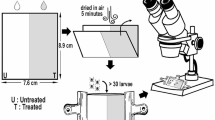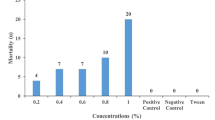Abstract
Larval packet test was used for assessment of resistance status against cypermethrin and deltamethrin in Hyalomma anatolicum and Rhipicephalus microplus from various districts of Punjab (India). Among the various field isolates of H. anatolicum susceptible status was recorded against cypermethrin in all isolates, whereas against deltamethrin resistance status (level I–III) was recorded. In R. microplus lower resistance levels (I–II) were recorded against cypermethrin in comparison to deltamethrin (level I–IV). Quantitative analysis of general esterase activity revealed a range of 4.21 ± 0.46 to 6.05 ± 0.55 and 2.23 ± 0.23 to 2.66 ± 0.24 µmol/min/mg protein for α- and β-esterase activity, respectively, in different field isolates of H. anatolicum and the increase in comparison to susceptible was not significant (P > 0.05). In contrast to H. anatolicum, the α- and β-esterase activity in all field isolates (except Jalandhar) of R. microplus was higher (range of 3.89 ± 0.26 to 10.85 ± 0.47 and 1.75 ± 0.08 to 5.87 ± 0.29 µmol/min/mg protein, respectively) (P < 0.001). The glutathione-S-transferase (GST) activity in field isolates of H. anatolicum and R. microplus was in the range of 0.01 ± 0.001 to 0.03 ± 0.001 and 0.02 ± 0.0003 to 0.03 ± 0.001 mM/mg/min. The enzyme ratios (α-and β-esterase and GST) and RR95 against deltamethrin of H. anatolicum isolates were correlated (P < 0.05), whereas in R. microplus only α-and β-esterase and RR50 against deltamethrin were correlated (P < 0.05).






Similar content being viewed by others
References
Annual Report (2011–12) Department of Animal Husbandry, Dairying and Fisheries, Ministry of Agriculture, Government of India, New Delhi, pp 36–48
Bradford M (1976) A rapid and sensitive method for quantification of microgram quantities of protein utilizing the principles of protein dye binding. Anal Biochem 72:248–254
Chevillon C, Ducornez S, de Meeus T, Koffi BB, Gaia H, Delathiere JM, Barre N (2007) Accumulation of acaricide resistance mechanisms in Rhipicephalus (Boophilus) microplus (Acari: Ixodidae) populations from New Caledonia Island. Vet Parasitol 147:276–288
de Castro JJ (1997) Sustainable tick and tick-borne disease control in livestock improvement in developing countries. Vet Parasitol 71:77–97
Devonshire AL, Williamson MS, Moores GD, Field LM (1993) Analysis of the esterase genes conferring insecticide resistance in peach-potato aphid, Myzus perspicae. Biochem J 294:569–574
Drummond RO, Ernst SE, Trevino JL, Gladney WJ, Graham OH (1973) Boophilus annulatus and Boophilus microplus: laboratory test of insecticides. J Econ Entomol 66:130–133
Enayati AA, Asgarian F, Amouei A, Sharif M, Mortazavi H, Boujhmehrani H, Hemingway J (2010) Pyrethroid insecticide resistance in Rhipicephalus bursa (Acari, Ixodidae). Pestic Biochem Physiol 97:243–248
FAO (1971) Recommended methods for the detection and measurement of resistance of agricultural pests to pesticides-tentative method for larvae of cattle tick, Boophilus microplus spp. FAO method No. 7. FAO Plant Prot Bull 19:15–18
FAO (2004) Resistance management and integrated parasite control in ruminants–guidelines, module 1 – ticks: acaricide resistance: diagnosis, management and prevention. Food and Agriculture Organization, Animal Production and Health division, Rome, pp 25–77
Finney DJ (1962) Probit analysis-a statistical treatment of the response curve. Cambridge University Press, Cambridge, pp 1–318
Flores AE, Albeldano-Vazquez W, Salas IF, Badii MH, Loaiza H, Garcia GP, Lozano S, Brogdon WG, Black IVWC, Beaty B (2005) Elevated α-esterase levels associated with permethrin tolerance in Aedes aegypti (L.) from Baja California, Mexico. Pestic Biochem Physiol 82:66–78
Ghosh S, Bansal GC, Gupta SC, Ray DD, Khan MQ, Irshad H, Shahiduzzaman M, Seitzer U, Ahmed JS (2007) Status of tick distribution in Bangladesh, India and Pakistan. Parasitol Res 101:S207–S216
Ghosh S, Ray DD, Vanlahmuaka, Das G, Singh NK, Sharma JK, Azhahianambi P (2008) Progress in development of vaccine against Hyalomma anatolicum anatolicum-Indian scenario. Vaccine 26S:G40–G47
Graf JF, Gogolewski R, Leach-Bing N, Sabatini GA, Molento MB, Bordin EL, Arantes GJ (2004) Tick control: an industry point of view. Parasitology 129:S427–S442
Grisi L, Massard CL, Moya Borja GE, Pereira JB (2002) Impacto economico das principais ectoparasitoses em bovinos no Brasil. Hora Vet 21:8–10
Guerrero FD, Lovis L, Martins JR (2012) Acaricide resistance mechanisms in Rhipicephalus (Boophilus) microplus. Rev Bras Parasitol Vet 21:1–6
Habig NH, Pabst MJ, Jakoby WB (1974) Glutathione S-transferase: the first enzymatic step in mercapturic acid synthesis. J Biol Chem 249:7130–7139
Haque M, Jyoti Singh NK, Rath SS, Ghosh S (2011) Epidemiology and seasonal dynamics of ixodid ticks of dairy animals of Punjab state, India. Indian J Anim Sci 81:661–664
Harley KLS (1966) Studies on the survival of the nonparasitic stages of the cattle tick Boophilus microplus in three climatically dissimilar districts of North Queensland. Aust J Agric Res 17:387–410
He H, Chen AC, Davey RB, Ivie GW, George JE (1999) Characterization and molecular cloning of glutathione S-transferase gene from the tick, Boophilus microplus (Acari: Ixodidae). Insect Biochem Mol Biol 29:737–743
Hemingway J (1998) Techniques to detect insecticide resistance mechanism (field and laboratory manual). Document WHO/CTD/CPC/MAL/98.6. World Health Organization, Geneva
Hernandez R, He H, Chen AC, Ivie GW, Waghela SD, George JE, Wagner GG (2000) Identification of a point mutation in an esterase gene in different populations of the southern cattle tick Boophilus microplus. Insect Biochem Mol Biol 30:969–977
Jamroz RC, Guerrero FD, Pruett JH, Oehler DD, Miller RJ (2000) Molecular and biochemical survey of acaricide resistance mechanisms in larvae from Mexican strains of the southern cattle tick, Boophilus microplus. J Insect Physiol 46:685–695
Jonsson NN, Miller RJ, Robertson JL (2007) Critical evaluation of the modified-adult immersion test with discriminating dose bioassay for Boophilus microplus using American and Australian isolates. Vet Parasitol 146:307–315
Kumar A, Mahour K, Gupta VK, Vihan VS (2006) Susceptibility and relative resistance in tick population against cypermethrin in organized farm and field animals. Vet Pract 7:41–43
Kumar S, Paul S, Sharma AK, Kumar R, Tewari SS, Chaudhuri P, Ray DD, Rawat AKS, Ghosh S (2011) Diazinon resistant status in Rhipicephalus (Boophilus) microplus collected from different agroclimatic zones of India. Vet Parasitol 181:274–281
Kumar R, Nagar G, Sharma AK, Kumar S, Ray DD, Chaudhuri P, Ghosh S (2013) Survey of pyrethroids resistance in Indian isolates of Rhipicephalus (Boophilus) microplus: identification of C190A mutation in the domain II of the para-sodium channel gene. Acta Trop 125:237–245
Kunz SE, Kemp DH (1994) Insecticides and acaricides: resistance and environmental impact. Rev Sci Tech OIE 13:1249–1286
Li AY, Davey RB, Miller RJ, George JE (2003) Resistance to coumaphos and diazinon in Boophilus microplus (Acari: Ixodidae) and evidence for the involvement of an oxidative detoxification mechanism. J Med Entomol 40:482–490
Lovis L (2012) Evaluation of acaricide resistance in the cattle tick, Rhipicephalus (Boophilus) microplus using a new in vitro test and molecular tools. PhD thesis submitted to Universite de Neuchatel, Switzerland
Lovis L, Guerrero FD, Miller RJ, Bodine DM, Bruno Betschart B, Sager H (2012) Distribution patterns of three sodium channel mutations associated with pyrethroid resistance in Rhipicephalus (Boophilus) microplus populations from North and South America, South Africa and Australia. Int J Parasitol Drugs Drug Resist 2:216–224
Minjauw B, Mc Leod A (2003) Tick-borne diseases and poverty. The impact of ticks and tick borne diseases on the livelihood of small scale and marginal livestock owners in India and eastern and southern Africa. Research report, DFID Animal Health Programme, Centre for Tropical Veterinary Medicine, University of Edinburgh, U K, pp. 59–60
Nolan J, Wilson JT, Green PE, Bird PE (1989) Synthetic pyrethroid resistance in field samples in the cattle tick (Boophilus microplus). Aust Vet J 66:179–182
Playford M, Rabiee AR, Lean IJ, Ritchie M (2005) Review of research needs for cattle tick control, Phases I and II. Meat & Livestock Australia Ltd, Sydney
Saldivar L, Guerrero FD, Miller RJ, Bendele KG, Gondro C, Brayton KA (2008) Microarray analysis of acaricide-inducible gene expression in the southern cattle tick, Rhipicephalus (Boophilus) microplus. Insect Mol Biol 17:597–606
Schnitzerling HJ, Nolan J, Hughes S (1983) Toxicology and metabolism of some synthetic pyrethroids in larvae of the cattle tick Boophilus microplus (Can.). Pestic Sci 14:64–72
Sharma AK, Kumar R, Kumar S, Nagar G, Singh NK, Rawat SS, Dhakad ML, Rawat AKS, Ray DD, Ghosh S (2012) Deltamethrin and cypermethrin resistance status of Rhipicephalus (Boophilus) microplus collected from six agro-climatic regions of India. Vet Parasitol 188:337–345
Shaw RD (1966) Culture of an organophosphorus resistant strain of Boophilus microplus (Canestrini) and assessment of its resistance spectrum. Bull Entomol Res 56:398–405
Shyma KP, Kumar S, Sharma AK, Ray DD, Ghosh S (2012) Acaricide resistance status in Indian isolates of Hyalomma anatolicum. Exp Appl Acarol 58:471–481
Singh NK, Rath SS (2013) Epidemiology of ixodid ticks in cattle population of various agro-climatic zones of Punjab. Asian Pac J Trop Med 6:947–951
Singh NK, Rath SS (2014) Esterase mediated resistance against synthetic pyrethroids in field populations of Rhipicephalus (Boophilus) microplus (Acari: Ixodidae) in Punjab districts of India. Vet Parasitol 204:330–338
Singh NK, Haque M, Jyoti, Rath SS (2010) Studies on acaricide resistance in Rhipicephalus (Boophilus) microplus against synthetic pyrethroids by adult immersion test with a discriminating dose. J Vet Parasitol 24:207–208
Singh NK, Haque M, Jyoti, Singh H, Rath SS, Ghosh S (2014) A comparative study on cypermethrin resistance in Rhipicephalus (Boophilus) microplus and Hyalomma anatolicum from Punjab (India). Ticks Tick Borne Dis 5:90–94
Singh NK, Jyoti, Rath SS (2013) Detection of acaricidal resistance in Hyalomma anatolicum anatolicum. Indian Vet J 90:17–19
Stone BF, Haydock P (1962) A method for measuring the acaricide susceptibility of the cattle tick Boophilus microplus (Can.). Bull Entomol Res 53:563–578
Tiwari S, Ghosh SK, Ojha VP, Dash AP, Kamaraju R (2010) Reduced susceptibility to selected synthetic pyrethroids in urban malaria vector Anopheles stephensi: a case study in Mangalore city, South India. Malar J 9:179
Vatsya S, Yadav CL (2011) Evaluation of acaricide resistance mechanisms in field populations of Rhipicephalus (Boophilus) microplus collected from India. Int J Acarol 37:405–410
Wharton RH, Roulston WJ (1970) Resistance to ticks to chemicals. Annu Rev Entomol 15:381–404
Acknowledgments
Authors are thankful to the Director of Research-cum-Dean, PGS, GADVASU, Ludhiana for providing facilities to carry out the research work. This work was supported by University Grants Commission, New Delhi through Project No. F.No. 42-633/2013 (SR).
Author information
Authors and Affiliations
Corresponding author
Rights and permissions
About this article
Cite this article
Nandi, A., Jyoti, Singh, H. et al. Esterase and glutathione S-transferase levels associated with synthetic pyrethroid resistance in Hyalomma anatolicum and Rhipicephalus microplus ticks from Punjab, India. Exp Appl Acarol 66, 141–157 (2015). https://doi.org/10.1007/s10493-015-9884-5
Received:
Accepted:
Published:
Issue Date:
DOI: https://doi.org/10.1007/s10493-015-9884-5




